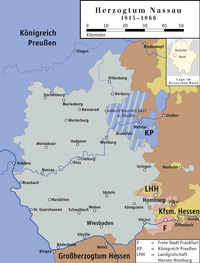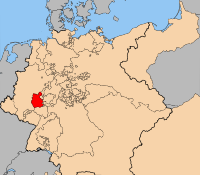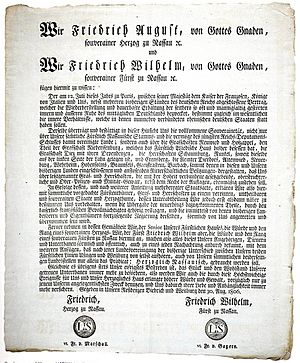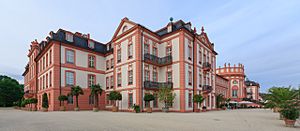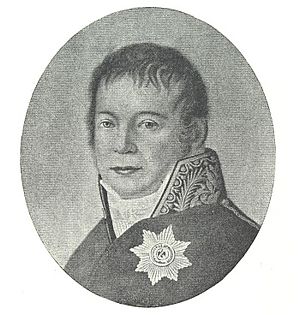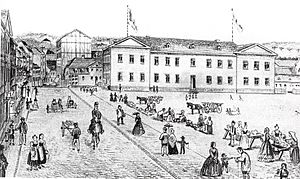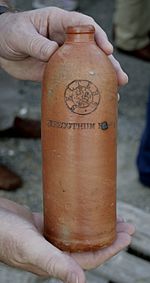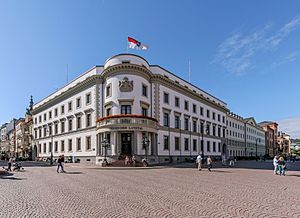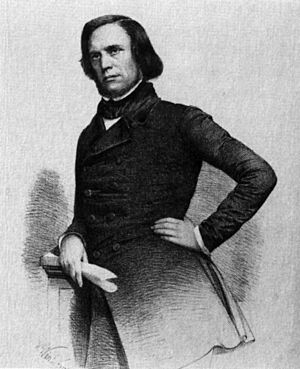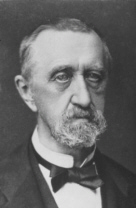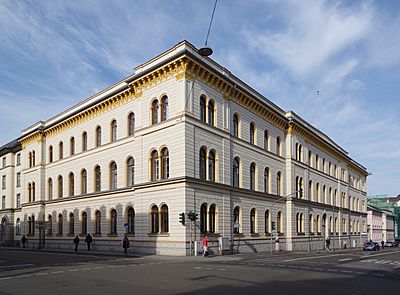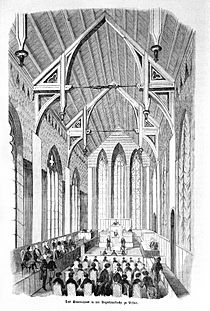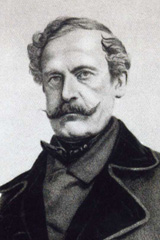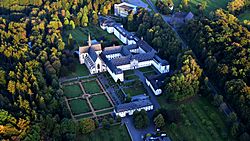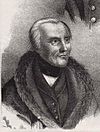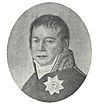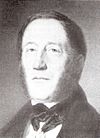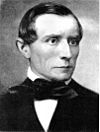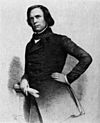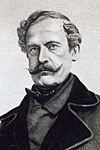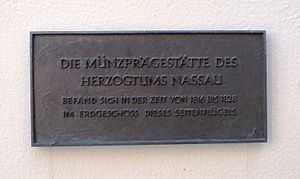Duchy of Nassau facts for kids
Quick facts for kids
Duchy of Nassau
Herzogtum Nassau (German)
|
|||||||||||||
|---|---|---|---|---|---|---|---|---|---|---|---|---|---|
| 1806–1866 | |||||||||||||
| Status | State of the Confederation of the Rhine (1806–1813) State of the German Confederation (1815–1866) |
||||||||||||
| Capital | Weilburg (1806–1816) Wiesbaden (1816–1866) |
||||||||||||
| Common languages | Moselle Franconian | ||||||||||||
| Government | Constitutional monarchy | ||||||||||||
| Duke | |||||||||||||
|
• 1806–1816
|
Frederick Augustus | ||||||||||||
|
• 1816–1839
|
William | ||||||||||||
|
• 1839–1866
|
Adolph | ||||||||||||
| Historical era | Modern era | ||||||||||||
|
• Established
|
30 August 1806 | ||||||||||||
|
• Annexed by Prussia
|
23 August 1866 | ||||||||||||
| Currency | Kronenthaler | ||||||||||||
|
|||||||||||||
The Duchy of Nassau (in German: Herzogtum Nassau) was an independent country in what is now parts of Germany. It existed from 1806 to 1866. This area is now in the German states of Rhineland-Palatinate and Hesse.
Nassau was a member of the Confederation of the Rhine and later the German Confederation. The family that ruled it was the House of Nassau. The duchy was named after its old main city, Nassau. However, Wiesbaden was its capital city.
In 1865, about 465,636 people lived in the Duchy of Nassau. In 1866, after a war, the Kingdom of Prussia took over Nassau. It became part of the Province of Hesse-Nassau. Today, the area is still known as the Nassau region. There is also a Nassau Nature Park there.
Today, the Grand Duke of Luxembourg still uses "Duke of Nassau" as a secondary title. Other members of the grand ducal family are called "Prince" or "Princess of Nassau." The Dutch royal family is also called the House of Orange-Nassau.
Contents
Geography of the Duchy
The Duchy of Nassau was mostly located in the Taunus and Westerwald mountain ranges. The Main and Rhine rivers formed its southern and western borders. The Lahn river separated the two mountain ranges in the north.
To the east and south, Nassau bordered the Grand Duchy of Hesse. The small Hesse-Homburg and the Free City of Frankfurt were also to the east. To the west was the Rhine Province of Prussia. Prussia also had a small area called Wetzlar inside eastern Nassau.
Population and Cities
When the Duchy was founded in 1806, it had about 302,769 people. Most citizens were farmers, day laborers, or artisans. In 1819, only 7% of people lived in towns with more than 2,000 residents. The rest lived in smaller villages or isolated homes.
Wiesbaden was the largest town with 5,000 people. Limburg an der Lahn was second with about 2,600 people. By 1847, Wiesbaden grew to 14,000 people, and Limburg to 3,400. Höchst am Main was the third-largest city.
History of Nassau
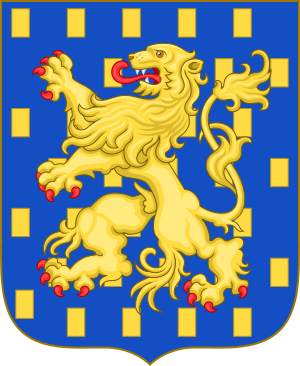
The House of Nassau family had many different branches over its long history. By the 1700s, the main branches were Nassau-Usingen, Nassau-Weilburg, and Nassau-Dietz. These branches had lands spread out in what is now the Netherlands and Belgium.
From 1736, the different Nassau family lines made agreements. These agreements stopped their lands from being split up even more. They also helped the branches work together politically. This cooperation helped set up the future unified Duchy.
How the Duchy Was Created
After a war (1792–1797), Nassau-Dietz lost its lands in Belgium and the Netherlands. Nassau-Usingen and Nassau-Weilburg lost all their lands west of the Rhine river to France. But like other German states, the Nassaus gained new lands. These new lands used to belong to the church.
The Nassaus got land from the Prince-Bishops of Mainz and Trier. In 1803, a special law called the Imperial Recess gave Nassau-Usingen and Nassau-Weilburg most of what they wanted.
- Nassau-Usingen lost some areas but gained others like Höchst and Lahnstein. It got back its lost population and more income.
- Nassau-Weilburg lost some areas but gained lands from Trier, including Ehrenbreitstein and Limburg an der Lahn. It also gained more people and income.
The princely family also gained a lot of forest and farmland. This land made up a big part of their total income.
In 1802, both Nassau principalities sent troops to take over the new lands. People in these new areas generally welcomed the new Nassau rulers. They thought Nassau was more liberal than the old church rulers. Between 1802 and 1804, many monasteries were closed. The lands of many small independent knights were also taken over. These takeovers were confirmed in 1806.
On July 17, 1806, Prince Frederick Augustus of Nassau-Usingen and his cousin Prince Frederick William of Nassau-Weilburg joined the Confederation of the Rhine. This group was allied with Napoleon I. Frederick Augustus became the Duke of Nassau, and Frederick William became the Prince of Nassau.
Under Napoleon's influence, the two areas merged to form the Duchy of Nassau on August 30, 1806. They ruled together. This was easier because Frederick Augustus had no male heirs, so Frederick William was already set to inherit his lands.
At the Congress of Vienna in 1815, Nassau gained more land. The Orange-Nassau family gave up their principality to Prussia. Prussia then gave part of it to the Duchy of Nassau.
Frederick William died in 1816. His son, William, became the sole Duke of Nassau after Frederick Augustus died in March 1816.
Reforms and New Laws
The first years of the Duchy saw many important changes.
- In 1806, serfdom (a system where people were tied to the land) was ended.
- In 1810, people gained freedom of movement.
- In 1812, a new tax system replaced many old taxes.
- Harsh physical punishments were stopped.
- A new law helped people manage their land better.
The Duchy was first divided into three districts in 1809. In 1816, Wiesbaden became the only capital. The number of smaller administrative areas was reduced. In 1817, "combined schools" were started for different religions. In 1818, Nassau created the first statewide public health system in Germany.
The Constitution of 1814
On September 2, 1814, Nassau got a new constitution. It was the first modern constitution in any German state. It allowed for some parliamentary involvement, especially in taxes. This was seen as a "Parliamentary Constitution" at the time.
The constitution protected individual freedom, religious tolerance, and freedom of the press. However, later laws, like the Carlsbad Decrees of 1819, limited these freedoms in Nassau and other places.
In 1849, a new constitution was made to meet demands from the German revolutions of 1848–49. But this new constitution was cancelled in 1851, and the old one was brought back.
Nassau's Parliament
Under the 1814 constitution, Nassau's Parliament (Landstände) had two parts. One was a chamber of deputies, and the other was a house of lords. The house of lords had eleven members, who were princes or nobles. The chamber of deputies had twenty-two members. Most were elected by landowners, but there were also representatives for church leaders and teachers.
The first election in the Duchy happened in 1818. Only a small number of people could vote. This included 39 nobles, 1,448 large landowners, and 128 wealthy city dwellers. At that time, the Duchy had about 287,000 people. The Parliament first met on March 3, 1818.
The Domain Dispute
When the Duchy was founded, the Duke's personal money and property (called the "domain") were kept separate from state taxes. The domain included royal lands, farms, and mineral water springs. This money belonged to the Duke and could not be used for state expenses. Parliament also had no say over it.
People quickly criticized this system. The head of Parliament, Carl Friedrich Emil von Ibell, complained about it often. This led to his removal in 1821. The debate continued for years. In 1831, after unrest in other countries, the issue became very heated. The government stopped people from sending petitions to the Duke about it.
On March 24, 1831, the deputies in Parliament suggested that the domain should belong to the people. The government disagreed and stopped public meetings on the topic. They even called in troops from a nearby state to prevent a revolt. However, no revolt happened.
The president of the chamber, Georg Herber, was a key figure for the deputies. He wrote strongly against the government. In 1832, Herber was sentenced to three years in prison for criticizing the Duke and the Chief Minister. He was arrested but released on bail. Herber was very ill and died in 1833, so the sentence was never carried out.
The Duke's government expanded the house of lords in 1831. This made the common citizens a minority in Parliament. They could not stop the Duke's taxes. Officials who supported the citizens were punished or fired. Liberal newspapers from outside Nassau were banned.
In March 1832, new elections for the lower chamber were held. But the deputies demanded that the house of lords be reduced in size. When the government refused, the deputies left the chamber on April 17. Only a few members remained and approved the Duke's taxes.
Duke Adolphe Takes Over
After the Domain Dispute, Nassau's politics became calmer. In 1835, Nassau joined the Zollverein, a German customs union. In 1839, Duke William died. His 22-year-old son, Adolphe, became the new Duke.
Duke Adolphe moved his home to the Wiesbaden City Palace in 1841. In 1845, he married Russian Grand Duchess Elizabeth Mikhailovna. She died a year later during childbirth. To honor her, he built the Russian Orthodox church in Wiesbaden.
From 1844, many community groups started in Nassau, like trade and sports clubs. These groups were not political at first, but they became important during the upcoming Revolution. Wiesbaden was also a center for a new religious movement called German Catholicism.
The government tried some small reforms in 1845 and 1846. In 1847, Parliament discussed laws about press freedom and animal damage to land. These were in response to complaints from farmers about the Duke's hunting.
The Revolution of 1848
Like many parts of Europe, Nassau experienced a wave of revolution in 1848. This happened after the February Revolution in France. On March 1, a group of liberals in Wiesbaden presented a list of demands to the government. These demands included civil freedoms, a German national assembly, and new election laws.
The next day, the "Nine Demands of the Nassauers" were given to Chief Minister Emil August von Dungern. He quickly approved a citizens' militia, freedom of the press, and a meeting of Parliament to discuss election reform.
On March 4, about 40,000 men gathered in Wiesbaden. Many were farmers with tools, wanting an end to old feudal rules and easier forest and hunting laws. The Duke announced from his balcony that he would meet all their demands. The crowd then peacefully left.
With freedom of the press, thirteen political newspapers appeared quickly. Many local papers also started printing political articles.
By the second week of March, election reform was the main topic. Liberals wanted voting rights not to depend on how much property someone owned. Parliament discussed this. The lower chamber agreed that the future parliament should have one chamber with 40–60 members. They also agreed to remove the property requirement for voting.
On April 5, the new election law took effect. It said that every hundred people would choose an elector. These electors would then meet in colleges to choose members of Parliament. More groups could now vote, including nobles, officials, and Jews. However, people receiving poor relief or who were bankrupt could not vote.
Meanwhile, on March 31, the Pre-Parliament met in Frankfurt-am-Main. Fifteen of its members were from Nassau's Parliament.
Chaos grew in rural areas. Many officials lost their jobs, so administration was disorganized. Farmers stopped paying taxes and chased away forest rangers. Young officials and teachers often encouraged radical democracy. The Duke's government tried to calm the rural people. They offered pardons for hunting crimes, allowed free elections for local leaders, and ended the last feudal dues.
In cities, people formed their own neighbourhood watch groups to deal with lawlessness. In Wiesbaden, a central safety committee for all of Nassau was formed. It was led by August Hergenhahn. Hergenhahn became a moderate liberal leader of the revolution. He also gained the trust of Duke Adolphe. When Emil August von Dungern resigned, the Duke appointed Hergenhahn as Chief Minister on April 16.
The 1848 Elections
As elections for the Nassau Parliament approached, political groups formed. Bishop Peter Joseph Blum of Limburg encouraged Catholic groups in rural areas. They had a clear program of 21 principles.
On April 4, a radical liberal pamphlet appeared in Wiesbaden, opposing the Catholic groups. The next day, a newspaper announced a Democratic-Monarchist opposition party.
The Ducal government prepared for the elections to both the Nassau Parliament and the Pan-German Frankfurt Parliament. It was hard to create voter lists, and people protested unfair voting limits. For example, adult sons of artisans and farmers could not vote if they worked for their fathers.
On April 18, the election of the electoral colleges took place. The total number of voters in the Duchy is not certain, but estimates are between 84,000 and 100,000 people (20–23%). Turnout varied, with more people voting in cities than in the countryside. Many problems were reported in the election process. Promises of lower taxes were common. People often elected socially important figures like mayors, teachers, or clergy. Catholics provided pre-marked ballots, which was against the law and criticized by liberals.
The 4,000 electors chose Nassau's six representatives for the Frankfurt Parliament on April 25. It was hard to find suitable candidates. Most chosen were government employees.
- In District 1, Procurator Carl Schenck was elected.
- In District 4, Friedrich Schepp was chosen.
- In District 2, Freiherr Max von Gagern won. He was a devoted Catholic and close to the Duke.
- In District 3, Friedrich Schulz was elected. He was a headmaster and editor who supported reforms.
- In District 5, Karl Philipp Hehner won. He had radical views and focused on a Republic.
- In District 6 (Wiesbaden), August Hergenhahn himself won.
In 1848, Nassau's representatives in the Frankfurt Parliament formed groups. Von Gagern, Hergenhahn, and Schep joined the moderate liberal Casino faction. Schulz and Hehner joined the center-left Westendhall group. As the Frankfurt Parliament fell apart, many resigned. Hehner and Schulz remained until the Parliament was dissolved in June 1849.
In the election for the Nassau Parliament on May 1, local interests were more important. Most successful candidates were civil servants and mayors. Few Catholics or Catholic clergy were elected.
End of the Revolution
The Nassau Parliament first met on May 22, 1848. Over the summer, political groups formed. Unrest continued in Nassau. In July 1848, there were clashes over the Duke's right to veto Parliament's decisions. The left wing of Parliament did not recognize this power, but the right wing and the Duke's government insisted on it.
This dispute led to unrest among the people. Hergenhahn called in Prussian and Austrian troops, who stopped the riots in Wiesbaden. In September, after fighting in Frankfurt, federal troops occupied part of the Taunus region.
Political groups and newspapers became more active. The Freie Zeitung became the voice of the left wing and often criticized the governments of Prussia and Nassau. Other papers, like the Nassauische Allgemeine, started supporting a constitutional monarchy.
By late 1848, the revolutionary movement was slowing down. Most newspapers stopped publishing because sales dropped and the Duke's government began to control the press. The Nassauische Allgemeine became dependent on the Duke's government. By late 1849, there was widespread censorship again.
Many political groups formed in autumn 1848, mostly supporting democratic ideas. By the end of 1848, about fifty organizations joined together as the Kirberger Union. However, the democratic movement quickly collapsed in the following months. By mid-1849, there were no active democratic groups. Some groups supporting a constitutional monarchy formed, creating an umbrella organization called the Deutsche Vereine (German Society) in Wiesbaden.
Elections for the Erfurt Parliament
After the Frankfurt Parliament collapsed, there was conflict between Prussia, Austria, and smaller German states. Nassau supported Prussia's plan to create a Union Parliament in Erfurt. On December 3, 1849, the Ducal government held elections for this new body.
Even though political movements were weaker, there was still an election campaign. Constitutionalists and the government wanted high voter turnout to support Prussia's plans for a monarchist Germany. Democrats tried to ensure low voter turnout. They wanted the Frankfurt Constitution to be put into effect.
On January 20, 1850, the initial election of the electoral college took place in Nassau. Voter turnout was lower than in 1848, ranging from 1% to 20%. In some areas, the vote could not happen due to low turnout and had to be rescheduled. The men chosen for the electoral colleges were all civil servants.
On January 31, the electoral colleges chose Carl Wirth, Max von Gagern, August Hergenhahn, and the Duke's brother-in-law Hermann, Prince of Wied as Nassau's representatives to the Erfurt Parliament.
The Restoration Period
After a short calm period, Duke Adolphe began to reverse some of the freedoms. There were conflicts between the Duke and Chief Minister Friedrich von Wintzingerode, who was only moderately conservative. He resigned in 1851. His replacement, August Ludwig von Sayn-Wittgenstein-Berleburg, took office in 1852. With his help, the Duke reduced freedoms and removed liberal officials. By mid-1852, almost all political groups were banned.
In 1849, the government suggested new elections for a two-chamber Parliament. The upper chamber would be elected by wealthy citizens. Liberals opposed this, but constitutional monarchists supported it. In September 1850, the government proposed a new plan for a 24-member chamber. The Duke dissolved Parliament on April 2, 1851. On November 25, the Duke finally set rules for a Parliament similar to the one before 1848.
Elections for the upper chamber were held on February 14 and 16, 1852. Less than a hundred wealthy landowners and merchants voted for its six members. The electoral college for the lower house was elected on February 9. Only 3–4% of eligible voters participated. In some areas, elections could not happen due to lack of interest. Unlike the previous Parliament, farmers were the largest group in the new lower house.
Strong political disagreements returned in 1864. The government planned to sell Marienstatt Abbey in the Westerwald. The abbey had been taken from the church in 1803 and was privately owned. In 1841, the Duchy bought it to turn it into a home for the elderly and poor. But the buildings were in bad condition.
By the 1860s, the buildings were even worse. The diocese of Limburg wanted to buy it for an orphanage. The government also wanted to sell it because it was expensive to maintain. The abbey was sold on May 18, 1864.
In elections on November 25, 1863, liberals won a large majority in Parliament's lower chamber. They wanted privileges given to the Catholic church to be extended to other religious groups. On June 9, 1864, the liberals in Parliament argued against selling the Abbey. They said it was worth more than the selling price and that Parliament had a right to stop land sales. Government officials denied Parliament had this right. They stressed the social good the building would do after being sold. A fierce debate happened between members who supported and opposed the church. Despite Parliament's opposition, the sale went through.
End of the Duchy
When the Austro-Prussian War began on June 14, 1866, the Duchy of Nassau sided with Austria. Prussia won the war at the Battle of Königgrätz on July 3. A small victory for Nassau near Wiesbaden on July 12, 1866, did not stop Prussia from taking over Nassau. Nassau became the Wiesbaden Region within the Province of Hesse-Nassau.
Before the Prague Peace on August 23, 1866, King William I of Prussia announced that Prussia would take over Hannover, Hesse-Kassel, the city of Frankfurt, and Nassau. Both houses of the Landtag of Prussia (Prussian Parliament) approved this. The law was passed on September 20, 1866. This made the people of Nassau citizens of Prussia.
Duke Adolphe, the last Duke of Nassau, received 15,000,000 guilders as payment. He also kept Biebrich Palace, Schloss Weilburg, and other properties. In 1890, he became Grand Duke of Luxembourg when the male line of Orange-Nassau ended.
In 1868, Nassau, Frankfurt, and Hesse were combined into the new Prussian province of Hesse-Nassau. The capital of this new province was Kassel. Nassau and Frankfurt became the administrative region of Wiesbaden.
In 1945, most of the old Duchy of Nassau became part of the German state of Hesse. Wiesbaden remained an administrative region within Hesse until 1968. A small part of the Duchy became the administrative region of Montabaur in the state of Rhineland-Palatinate.
Politics of the Duchy
Foreign Affairs
Nassau's location and small economy limited its power in foreign affairs. During Napoleon's time, it had no independence. The Nassau army had to follow Napoleon's orders. In 1806, they were stationed in Berlin. Three battalions fought in the Siege of Kolberg. Two infantry regiments and two cavalry squadrons fought for over five years in the Peninsular war in Spain. Only half of them returned.
In November 1813, Nassau joined the War of the Sixth Coalition against Napoleon. Nassau troops also fought at the Battle of Waterloo. Of 7,507 men, 887 were killed. After the Congress of Vienna in 1815, Nassau became a member of the German Confederation.
Military
Nassau's military policy was shaped by its membership in the German Confederation. The military was reformed to combine the different forces from Nassau's older states into one army.
The army mainly had two infantry regiments, created in 1808–1809. During the Napoleonic Wars, Jäger (light infantry) squadrons supported them. After the Battle of Waterloo, the Duchy added an artillery company. The whole military was under a brigade command. The Duke was the head, but an Adjutant general managed daily operations. Usually, the Nassau army had about 4,000 soldiers.
After Prussia took over the Duchy, most Nassau officers and soldiers joined the Prussian Army.
Education
The Duchy could not afford its own university. So, Duke William I made an agreement with the Kingdom of Hannover. This allowed Nassau citizens to study at the University of Göttingen. To pay for schools and university scholarships, Duke William created the Nassau Central Study Fund in 1817. This fund still exists today.
At Göttingen, some non-Nassau students sometimes secretly got free dinners paid by this fund. The German word nassauer, meaning 'someone who takes advantage of something they are not entitled to', is said to come from this. However, language experts say the word actually comes from an old dialect and this story was made up later.
Religion
Because the Duchy was made of different territories, it had various religions. In 1820, about 53% were United Protestants, 45% were Catholic, and 1.7% were Jewish. Most villages and cities were mainly one of the two Christian groups.
Like in other Protestant parts of Germany, the church was controlled by the state. The Lutheran and Reformed churches in Nassau agreed to unite in 1817. This made them the first united Protestant church in the German Confederation.
In 1821, the Duchy of Nassau and the Holy See (the Pope's government) agreed to create a Catholic diocese of Limburg. It was officially established in 1827.
Religious groups also played a role in state politics. The Poor Handmaids of Jesus Christ, a religious group founded in Dernbach, soon took charge of caring for the sick. The Duchy's government tolerated and even supported them because doctors praised their work. They set up "hospitals" or mobile medical stations in many places.
Dukes of Nassau
| Duke | Image | Birth | Death | Reign |
|---|---|---|---|---|
| Frederick Augustus | 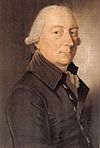 |
23 April 1738 | 24 March 1816 | 30 August 1806 – 24 March 1816 |
| William |  |
14 June 1792 | 20 August 1839 | 24 March 1816 – 20 August 1839 |
| Adolphe | 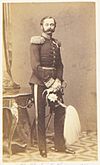 |
24 July 1817 | 17 November 1905 | 20 August 1839 – 20 September 1866 |
The Dukes of Nassau came from the Walram line of the House of Nassau. Members of this line still rule in the Grand Duchy of Luxembourg. The Grand Duke still uses "Duke of Nassau" as a special title.
The royal family of the Netherlands comes from the Ottonian line of Orange-Nassau. This line split from the Walramian line in 1255.
Chief Ministers
Economy
The Duchy's economy was not very strong. Most of the land was mountainous, which was not good for farming. It also made transportation difficult. Even so, more than a third of the people worked on small farms. They often had to earn extra money from other jobs, like selling goods as peddlers. Most tradesmen were artisans.
Currency
The Duchy used the south German currency system. The main money was the guilder. Up to 1837, 24 guilders were equal to one Cologne silver mark. A guilder was divided into 60 kreutzer. Smaller coins were made of silver and copper.
From 1816, there were also Kronenthaler coins, worth 2.7 guilders. The Duchy's mint was in Limburg from 1816 to 1828. In 1837, Nassau joined the Munich Coin Treaty. This treaty set the value of the silver mark at 24.5 guilders. After another treaty in 1838, the Thaler also became legal money. Two thalers were equal to 3.5 guilders.
In 1842, the Heller was introduced as the smallest coin, worth a quarter of a kreutzer. After the Vienna Currency Treaty of 1857, the Duchy also minted the Vereinsthaler. A Pfund (500 grams) of silver was worth 52.5 guilders or 30 thalers. The Heller was replaced by the Pfennige, also worth a quarter of a Kreutzer.
Paper money, called Landes-Credit-Casse-Scheine, was printed in Wiesbaden from 1840. They came in values of one, five, ten, and twenty-five guilders.
Images for kids
See also
 In Spanish: Ducado de Nassau para niños
In Spanish: Ducado de Nassau para niños




